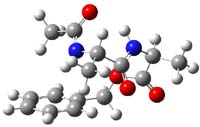Computing anions have long been understood to offer interesting challenges. For example, anions require diffuse functions for reasonable description. Jensen1 has now investigated the electron affinity of atoms and small molecules with three DFT methods: BHHLYP having 50% HF and 50% Becke exchange, B3LYP having 20% HF and 80% Becke exchange and BLYP with 100% Becke exchange. The result is that all three express varying degrees of electron loss from the atom or molecule in the anion. Thus the anionic species really possess only fractional anionic charge.
In cation-anion pairs or in large species that have strong electron acceptors and donors (say a protein), this electron loss manifests itself in less ionic character than what should actually be present. In other words density is erroneously moved off of the anionic center and transferred to the cationic center.
This error is due to poor description of the long-range exchange. Including the LC correction does eliminate the problem, and so one should be very careful in using DFT for anions.
References
(1) Jensen, F., "Describing Anions by Density Functional Theory: Fractional Electron Affinity," J. Chem. Theory Comput., 2010, 6, 2726-2735, DOI: 10.1021/ct1003324





